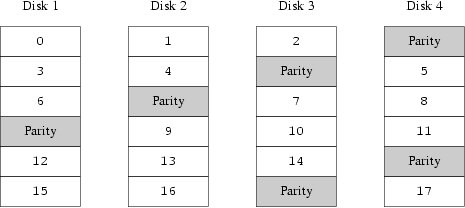13.4 Data integrity
The final problem with current disks is that they are unreliable. Although disk drive reliability has increased tremendously over the last few years, they are still the most likely core component of a server to fail. When they do, the results can be catastrophic: replacing a failed disk drive and restoring data to it can take days.
The traditional way to approach this problem has been mirroring, keeping two copies of the data on different physical hardware. Since the advent of the RAID levels, this technique has also been called RAID level 1 or RAID-1. Any write to the volume writes to both locations; a read can be satisfied from either, so if one drive fails, the data is still available on the other drive.
Mirroring has two problems:
-
The price. It requires twice as much disk storage as a non-redundant solution.
-
The performance impact. Writes must be performed to both drives, so they take up twice the bandwidth of a non-mirrored volume. Reads do not suffer from a performance penalty: it even looks as if they are faster.
An alternative solution is parity, implemented in the RAID levels 2, 3, 4 and 5. Of these, RAID-5 is the most interesting. As implemented in Vinum, it is a variant on a striped organization which dedicates one block of each stripe to parity of the other blocks: As implemented by Vinum, a RAID-5 plex is similar to a striped plex, except that it implements RAID-5 by including a parity block in each stripe. As required by RAID-5, the location of this parity block changes from one stripe to the next. The numbers in the data blocks indicate the relative block numbers.
Compared to mirroring, RAID-5 has the advantage of requiring significantly less storage space. Read access is similar to that of striped organizations, but write access is significantly slower, approximately 25% of the read performance. If one drive fails, the array can continue to operate in degraded mode: a read from one of the remaining accessible drives continues normally, but a read from the failed drive is recalculated from the corresponding block from all the remaining drives.



